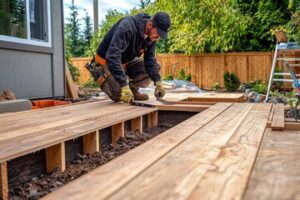When estimating lumber needs for a project, it’s important to include a 10-15% waste margin. This will help prevent running out of materials and make the project more cost-effective.

Before you begin a woodworking project, it’s essential to familiarize yourself with the five main woodworking cuts. Explore more about Custom Cut Wood in the sections below.
Many people choose to cut their own wood pieces to use in DIY projects. However, if you’re looking for precise cuts, it’s best to leave the cutting to professionals. This way, you’ll get the most out of your materials and avoid costly mistakes. You’ll also save time and energy by having the job done right the first time.
If you’re working with green (unfinished) lumber, you need to know it contracts and changes size as it dries. This means that it’s difficult to find lumber in the exact dimensions needed for a custom design. It’s important to look for a company that offers green timber cut to size services. This will ensure that you have the correct size material to complete your project.
Commercial buildings and other businesses require a lot of wood products to create attractive and functional spaces. From framing and sheathing to decorative elements and furniture, custom cut wood plays a key role in construction. It’s often used to add character, color and texture while boosting brand identity.
You can find a variety of tools to help you cut your wood, from basic hand saws to powerful power tools. When selecting a tool, be sure to check the warranty and after-sale support. A reliable warranty and customer service will show that the manufacturer stands behind its product, increasing your buying confidence.
When purchasing custom cut wood for a home or business, look for a lumber supplier that uses machine tools to make the cuts. This will ensure that the wood has clean and accurate edges, enhancing the overall appearance of the final piece. You can also use these tools to make angled cuts, such as miters or cross cuts.
Retail
For businesses that need wood in specific lengths, procuring it isn’t as easy as stopping by the local hardware store. For one, they typically don’t stock lumber that’s already cut down to size. Instead, industrial wood suppliers like Alderfer Lumber offer a simple purchasing solution bringing custom-sized wood directly to your facility.
These companies can help you turn lumber into something unique and eye-catching, making it the perfect promotional material or gift for your customers or business partners. They have woodworking experts that can work with different types of wood to create products in a wide range of styles and shapes. Some of these include soft edges, routered or burned-in letters and designs, varying thicknesses, and even special geometries.
Another way they can help you is by using specialized tools to cut wood and other materials. These tools ensure more accurate cuts that are smooth and clean, helping your finished product look its best. Also, the specialized machines help you avoid mistakes that could cost you time and money down the line.
Additionally, these wood cutting services can also make your project more economical. If you buy raw lumber and use it for your project, the process can be quite expensive. However, if you buy pre-cut wood that’s been manufactured by a company, you can save a lot of money.
Many Home Depot locations allow customers to have wood cut by their staff for free, without limiting how many cuts you get. This is a great service for DIYers and those who need just a few pieces of wood cut to exact dimensions. However, you should check with your local store’s policy for details.
Outdoor Furniture
Whether for decks, patios, or other outdoor spaces, Custom Cut Wood’s wood furniture pieces make great additions to home and commercial spaces. From tables to chairs and sofas, durable and aesthetically pleasing custom wood work is essential for creating engaging and welcoming environments. Custom wood works are also ideal for building and maintaining retail spaces, as they can be customized to fit specific needs and aesthetics.
When it comes to constructing wood furniture for the outdoors, it is important to choose a hardwood that is resistant to weathering and pests. A good place to start is by looking at where a particular wood falls on the Janka hardness scale, which measures how much a wood can withstand pressure and impact.
Eucalyptus, for example, is a popular choice for outdoor furniture because of its toughness and durability. It is also resistant to rot and insects, and it has a natural oil that helps protect it from the elements. Eucalyptus is also a sustainable source of wood, as it can be harvested and processed without damaging the trees that grow it.
Other types of wood commonly used for outdoor furniture include oak and pine. Both are durable and look beautiful, although pine may not last as long as some of the other options. It can be stained or painted to create a variety of looks, and it is typically treated with a preservative to prevent rot and insect infestation.
Another popular choice is poplar, which is a softwood that is easy to work with and has a uniform appearance. It is also relatively inexpensive and can be stained to match any decor. It is not as durable as some other hardwoods, however, and it is susceptible to dents.
Marine
Marine and marine operations utilize a lot of wood, especially in boats and other structures that are constantly immersed in water or moisture. They also need plywood that can stand up to the elements on a consistent basis. That’s why they use marine-grade plywood, which differs from regular exterior plywood in a few ways.
For example, it’s made with thicker layers of higher-quality wood, and it has far fewer air pockets and small voids than standard exterior plywood. Additionally, it’s typically bonded with waterproof glue. Marine-grade plywood is more durable and resistant to chemicals, weather damage, scratching, and denting.
As a result, it’s often used for projects like docks, piers, boat building, and siding for buildings or signs. But it’s also commonly found in other household areas, such as bathrooms, kitchens, patios, decks, and porches.
Getting the right plywood for these types of projects can be difficult, especially in rural areas. Fortunately, there are some online retailers that stock high-quality plywood that can meet the demands of many different construction needs. For instance, Chesapeake Plywood is a wholesale distributor that sells a variety of plywood and delivers it across America. They can even arrange exports to international customers.
Another online retailer is Cal Panel, which sells a variety of wood products including MDO marine-grade plywood. It’s made with tropical trees and offers a negligent core gap, which results in strong construction that’s considerably resistant to the elements. It’s also sanded, and knots and holes are patched up, creating smooth and aesthetically pleasing sheeting that takes paint well. It’s typically sold in 4x8ft pieces. Cal Panel can also provide custom cuts for larger orders.
Signage
Signage is a critical part of any business. Whether used externally to brand a storefront or internally to label conference rooms and offices, signs deliver a clear and professional presence that creates confidence in your company. While there is a variety of signage materials available today, wood remains a timeless option that can add a distinctive, natural charm to any business environment.
A customized sign can reinforce your brand and help you stand out from the competition. For example, a personalized wood welcome sign will give your customers a warm and inviting feel while also creating a cohesive branding experience that will boost customer confidence. In addition, custom wooden signs can improve navigation around large establishments by providing directions and streamlining the process of getting to various areas of a building.
Several different species of wood are ideal for crafting wooden signage. Hardwoods like oak and maple offer a rich, high-quality look while softwoods such as pine or cedar provide a more rustic appeal. Many signmakers also use composite materials such as MDF to make wood signs, since this material is affordable and durable and can stand up to harsh weather conditions.

